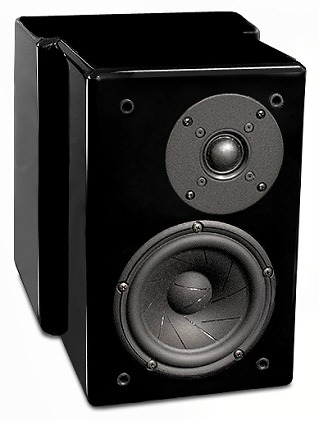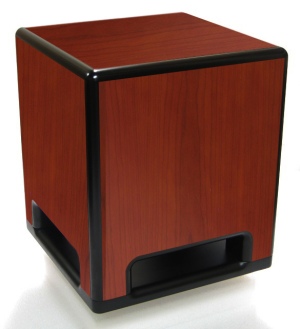|
You are reading the older HTML site
Positive Feedback
ISSUE
27
"You got me way down deep ..." Follow-Up to the ACI Sapphire XL Monitors - The Good Dr. Sardonicus Explores the Final Few Frequencies with the addition of the ACI Force XL-Subwoofer Introduction For some time now, I have been knocking about with one of my favorite small speakers ever, the ACI Sapphire XL. These Scan-Speak driven mighty-mouse two-way speakers have seen duty all over my house over the past few months, in practically every application imaginable. Frankly, I am having a hard time imagining being without them. Utterly charming affordable hi-fi. From cinema to full out, head-banging rock and roll, the ACIs deliver the musical goods ...with one slight reservation. At this point in time, with our current technology, no small two-way speaker with a sub-six inch woof is going to do low frequencies convincingly. That is a simple, cold fact. Bass is a problem I know a shocking number of audiophiles who have simply written off anything much below 50Hz as "irrelevant." To me that is like saying the meat closest to the bone is simply too much trouble to extract, when that is where the most flavor resides. The impact those low frequencies have on the overall listening experience is huge. But, Shirley MacLaine aside, physics is physics, and producing truly low bass (below 40Hz with significant SPL's) is pretty much impossible for a two-way, modestly sized monitor speaker. Enter one of the banes of audiophiles—the subwoofer But hey, that is why they make subs, right? While not quite as rancorously controversial as tone controls, subs have often stood their place on the whipping wall of audiophile snootery. The first reason subs are a bane to audiophiles is because they tend to boom. Well, Veronica, I hate to tell you this, but that is the nature of real bass. The dry, over-damped low frequency reproduction of most audiophile-darling speakers has little to do with how real bass sounds in the real world. Bass does not go tock tock, it goes BOOM BOOM. But it is a beautiful day, I have moved into a new place with a main room that promises to be quite excellent for listening, and I am not in the mood to tilt at that particular windmill ...today ...so I will stipulate to it. Many subs are perceived as sounding boomy to many audiophiles. The second aspect is both true and truly troublesome ...integration. We are told that bass is non-directional, so you can use one sub and put it wherever you wish ... pretty much. Functionally, that is crap. It might work for cinema, but it does not work well for audio. Try this: first set up a single sub behind your main speakers and in one of the corners. Listen; then set up two, identical subs, proximal to your speakers and away from the corners ...now, repeat after me, "low frequencies are non-directional" ...yeah right. And of course, we users set the crossover points too high and we set the volume too high; after all ...if we spend money on a sub, we want to HEAR it, right? No, no, Nanook!
The specs on the Sapphire XL monitors shows them having "usable" bass down to about 60Hz, which is actually quite respectable for a speaker of that size. However, there really isn't that much output at that level. If you assume all is well in that comforting typical two-way speaker specification of 60Hz +/- 3dB, you will simply set your sub(s) to cross at the lowest possible level to avoid boom, and you will miss the boat. The real goal is to dial the sub in high enough to give you a good, solid mid-bass substance without wooly-ing up the overall presentation, or compromising the true low bass. Your typical two-way speaker begins a precipitous drop in SPLs at about 100Hz. One wants to dial in subs to reach up from underneath and gradually start taking over the load. Start a little high and a little loud and go down from there until you cannot hear any discontinuity between the subs and the monitors. If a given placement will not allow that, move them around; start over again. Remember, one of the golden virtues of being an audiophile is patience. ACI recommends finding the place in the room where your spoken voice sounds the most natural to your ears, and put one sub there ... interesting. You try that out and let me know how it works for you. I suggest that you start by putting them slightly behind, and in close proximity to the main speakers. The further you get away from the mains, generally the greater the integration challenge. But, whatever general guidelines you follow, they will sound best where they sound best, and that takes time and patience. Every room is different. Enter the ACI Force XL Sub
You get a host of connection and setting
options with these little sweeties, enough to integrate them without
about anything, in about any room. But this is NOT an exact science and
you have to be willing to play with them. They are not heavy or
fragile, so this is pretty easy. You just need some hurking long
interconnects and a great deal of patience (best to drive the subs off
the pre-out of your preamplifier, unless you are running a true AV receiver,
in which case the HT mode makes more sense). I prefer the satin black finish myself because, like a Bunraku puppet master, you want to draw visual attention away from the subs. (Yes, there is a subtle, but nonetheless important psychological and neurological interaction between the visual and auditory aspects of a listening room). I think subs should be heard and not seen. It helps with integration, trust me. The satin blacks are more likely to "disappear" visually. Short of that, I suspect you would probably match them to your mains, if possible. Crossover points, placement, volume, phasing ...all have to be considered in conjunction with each other. Imagine dialing in a high performance sports car (tires, suspension, brakes, etc.). It all has to work together. (Oh, apropos of nothing other than the Zen of set up, if you have not seen the wonderful Chinese film, Initial D, and you like motor sports, it ROCKS!) Dialing-in any sub takes time, care and patience, and it is one of the major reasons people bag on subs so much, because they lack the listening skills and patience to tune them correctly. They plonk them down, turn them up, and then whine about the results. Der! Two of these ACI XL subs in conjunction with the ACI XL monitors create a hugely flexible and musical speaker system, all for just over $3K, total; massive sound with a diminutive foot print. Very tasty for the money. Jennifer Crock of JENA Labs suggested four of the subs, in opposite corners facing each other, directly out of phase with their opposite, and predicted that such a set-up would energize the room in a way virtually impossible to do with a conventional two-speaker (even with subs) system. I keep begging Jennifer to get help, but she just laughs at me. Short of that, I will have to beg ACI for another set just to test her hypothesis. But how do they sound? Fast, articulate, clean, and capable of startling slam for their size. Using the ACI XL monitors and subs in my AV system was a revelation. I will confess to being a bass head, ‘cause of all my years in live music. I do turn the sub volumes up a bit for movies and down a bit for music. I love the rumbling decay that pressurizes the house and makes movies like The Core, or The Abyss such an e-ride, visually and sonically. Dial the volume back just a tad and all trace of overhang pretty much disappears for critical music listening. However, be aware that the ACI XL Monitors are quite to the rich side, and this tendency is reinforced with adding the subs. The sweet, tubey sound of the Dussun 100 watt DS-99 ( https://positive-feedback.com/Issue24/dussun.htm ) mated with the ACI XL monitors and subs results in a big, wet kiss of a system, perhaps a bit too much so for some. The Dussun V-6 (150 watts) will be a more conventionally palatable choice. It is fast, articulate, detailed, and a bit less warm than its smaller brother; it also has separate pre-outs, which make the lash up much simpler. ACI may suggest 150 watts is overkill for the XLs, but it isn't. Slap a reasonably highly quality (perhaps one voiced just a tad towards the analytical side) front end on it and you will get a very musical synergy. At this price point you are going to be juggling euphony. Don't be afraid of it ...trust your ears and do some experimentation. This is the real fun of working at a more modest price level ...tuning the system to your preferences. Summary Remember, just as with sports cars, frequently the most meticulously set-up and driven produces the best times—not the most expensive or powerful. The XL Subs, like the XL monitors they were designed to complement, are extremely high quality/value products that will appeal enormously to the music lover. If you are searching for the arid, acid detail of the currently in-vogue faux high fidelity sound, look elsewhere for your undernourished, vapid and anorexic thrills. But if you are a music lover with space or economic considerations, and especially if your system has to do dual duty for movies and audio, this is great stuff. Specifications
Retail: $750 (some finishes extra)
Audio Concepts, Inc.
|


 Fact is, set up right, most of the time a
sub won't be doing much to be heard.
Fact is, set up right, most of the time a
sub won't be doing much to be heard.